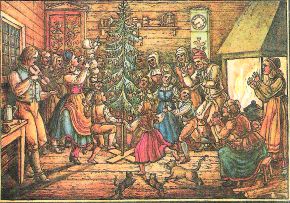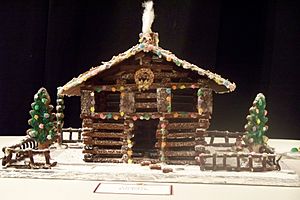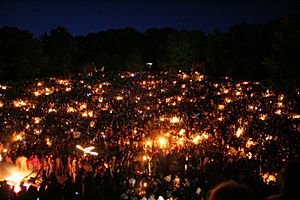Knut's party facts for kids
Quick facts for kids Knut's party |
|
|---|---|

Knut's dance or Dancing out Christmas, by Swedish artist Hugo Hamilton (1802–1871)
|
|
| Official name | Julgransplundring |
| Observed by | Sweden |
| Celebrations | Dancing around the Christmas tree, children's party, removing Christmas decorations |
| Date | 13 January |
| Next time | 13 January 2026 |
| Frequency | annual |
| Related to | Christmas, St. Knut's Day |
A Knut's party or Knut's dance is a fun tradition in Sweden. It happens on St. Knut's Day, which is January 13th. This day marks the official end of the long Christmas and holiday season.
The holiday season in Sweden includes many special days. These are Advent Sunday, Saint Lucy's Day, Christmas, New Year, and Epiphany. A Knut's party is also known as "Dancing out Christmas" (Dansa ut julen). Sometimes people call it "Throw out the Tree" (Kasta ut granen).
Contents
What is Knut's Party?
A Knut's party is a special way to say goodbye to Christmas. It's a time when families and communities gather. They take down their Christmas decorations. It's often a party, especially for children.
The History of Knut's Day
The tradition of ending Christmas on the 20th day after Christmas has been around since the 1600s in Sweden. This special day was first celebrated to honor a Danish duke named Canute Lavard.
Later, the celebration shifted to honor Canute IV of Denmark. He was a king and a patron saint of Denmark. During the Middle Ages, groups called Knutsgillen (like old trading companies) would sometimes hold big parties. The Swedish word for these gatherings, gille, also means "party." This might be why the tradition of feasting became part of the day.
An old book called the Old Farmer's Almanac mentions this day. It says, "King Knut asked them for help to drive out Christmas." In the past, in Swedish farming communities, children would run from farm to farm. They would "call out Christmas," meaning they announced that Christmas was over. They would also ask for food and drinks.
The way we celebrate Knut's party today hasn't changed much since the 1870s. In the 1900s, it became mostly a party for kids. It often involves candy and treats. The popularity of these parties was highest between 1950 and 1970.
How People Celebrate
In many homes, families have a party, mainly for children. This is when all the Christmas decorations are finally put away. These parties are also common in schools, kindergartens, and churches.
In many towns, the lights on the public Christmas tree are turned off. This is often followed by an outdoor Knut's dance for everyone in the community. In some places, this celebration is called Julgransskakning, which means "Shaking the Christmas tree."
Fun Party Activities
Party activities are full of fun. People sing and dance around the Christmas tree. A favorite part is "looting" the tree. This means taking off any candy or apples that were used as decorations.
Another popular activity is smashing the gingerbread house into pieces. Then everyone gets to eat it! People also open Christmas crackers that were used as tree decorations. Sometimes there are lotteries or a fiskdamm ("fishing pond"). In a fishing pond, children "fish" for toys and candy. A treasure hunt is another exciting game.
The songs and dances are often the same as those performed at Christmas and Midsummer. Some songs have special verses about Christmas ending.
What Happens to the Christmas Tree?
In the 1900s, people sometimes literally threw their Christmas trees out of windows or from balconies! This happened after the trees had been "plundered" and all their ornaments were removed.
Since the early 2000s, local authorities have set up special places to drop off trees. However, even in 2015, some people still dumped trees illegally.
Volunteers from sports clubs and other groups like Lions Clubs International often help collect the discarded trees. These trees can be recycled for heating homes. They can also be used in big bonfires during Walpurgis Night later in the spring. It's important to dispose of the tree properly in the designated areas to avoid problems.
Since the late 1980s, many people have started using artificial Christmas trees. These trees don't need to be thrown out. They are simply taken apart and stored away after the Knut's party.
Images for kids
-
Named for the Danish prince Canute Lavard
-
Walpurgis Night bonfires







